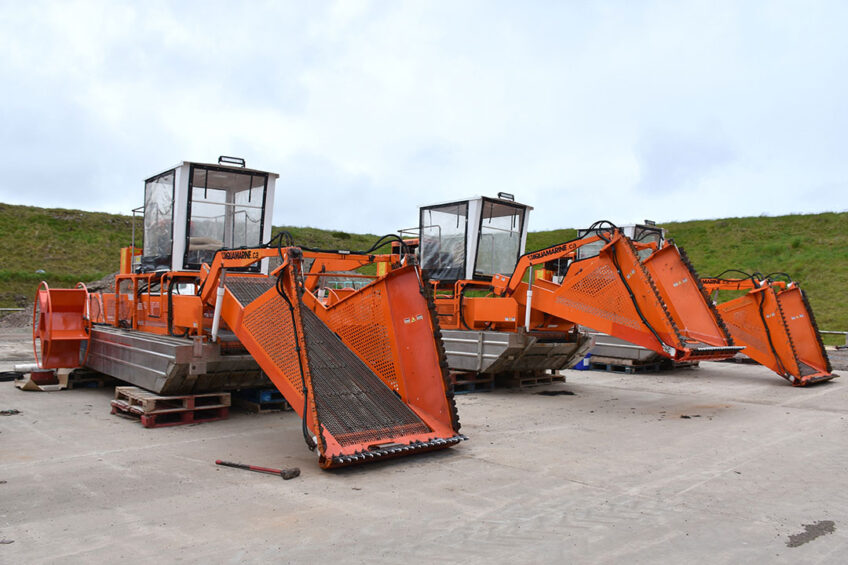Harvesting seaweed for cattle feed

Global demand for seaweed is on the increase as it is one of the most versatile and naturally occurring sources of vitamins and minerals for both humans and livestock.
It is also a good source of amino acids, antioxidants and essential fatty acids making seaweed an essential element in both human and livestock diets as well as for use as a soil fertiliser and in the cosmetics industry. Feeding seaweed to cattle has been proven to increase overall health and growth rates but more recently preliminary research has indicated a small amount of the marine algae added to cattle feed can reduce methane emissions from cattle gut microbes by as much as 99%.

Increased demand for seaweed
Sales of seaweed across the world reached over US$ 4 billion in 2016 and are predicted to rise to around US$ 10 billion by 2024. Asian countries are pushing sales higher as is strong demand from the US and Europe in all market sectors. This increased demand for seaweed has become so strong that one UK company harvesting and processing the algae in the Outer Hebrides, off the north west coast of Scotland, is now expanding its production facilities to meet that demand. Hebridean Seaweed Company Limited is the largest industrial seaweed processor in Great Britain and is based on the Isle of Lewis. Starting in 2006 the company manufactures seaweed products for use in animal feed supplements, soil enhancement, alginate and nutraceutical sectors.

Special permits needed for harvesting
With crystal clear waters to harvest from, the company was set up at Arnish Point near Stornoway by Martin Macleod and Malcolm Macrae, both of whom are from the nearby village of Leurbost. Currently, the production plant is undergoing a £7 million expansion project to cater for increased demand for seaweed products. Hebridean Seaweed already produces 6,000 tons of seaweed per year and exports it all over the world but demand is growing. Managing director Martin Macleod said: “Around 95% of our production is destined for the agricultural and horticultural markets and 5% is for food production and the cosmetic industry. “In the agricultural sector we mostly supply business to business including Glenside Organics in Scotland and Trouw Nutrition and also to some fish feed manufacturers.” Seaweed is harvested, as the name suggests, from the sea which is owned by the Queen of England. Special permits have to be authorised for any harvesting to take place on a regular basis.”

“We harvest the seaweed from the sea, which is ultimately owned by the Queen. We have agreements in place with the Crown Estate and local private estates to exclusively harvest ascophyllum nodosum throughout the Western Isles. Harvesting takes place all year round and the cutting is carried out mechanically using a fleet of seaweed harvesting boats that I designed and had built exclusively for us. We work very closely with Scottish Natural Heritage and SEPA to ensure the seaweed harvesting is sustainable and environmentally friendly,” he said.
Looking at different ways of drying seaweed
Although manual cutting of the seaweed was once the favoured method of harvesting, the mechanical harvesting is now preferred. The boats works close to the shore and cut the seaweed as the stalks float above the seabed. It is then filled into sacks and towed by a small boat to a sheltered area for loading onto a lorry. This method of harvesting is environmentally friendly and sustainable as only the tops of the stalks are cut which allows the seaweed to regenerate in a relatively short period of time. Mr Macleod said: “We have a licence to harvest 12 hours per day but we keep it at around 6 to 8 hours to ensure sustainability in regrowth. Up to 40 tonnes of fresh seaweed is harvested per day which equates to around 10 tonnes of processed seaweed as the ratio of fresh seaweed to processed product is around 4 to 1,” he said.

When the seaweed arrives at the processing plant it first has to be dried and then milled into the product requested by each customer. Mr Macleod is currently looking at different ways of drying seaweed including air drying to see which method is best. As part of the new production facility currently under construction he is installing a lot of new technology to ensure increased efficiency of energy and production methods.
“The entire new project is costing around £7 million and we have received grants from Europe and the Scottish government to assist with the construction. It extends to 3,250 square metres of covered facility and a further 17,000 square metres of yard space which is probably Europe’s biggest seaweed factory. We hope to have the unit completed within 10 months from starting as we have customer orders to honour and we will,” he added. One of the more unusual clients for Hebridean seaweed is Pinewood Studios who regularly request tonnes of the algae to decorate film sets with for various movie and TV productions.
Join 13,000+ subscribers
Subscribe to our newsletter to stay updated about all the need-to-know content in the dairy sector, two times a week.










